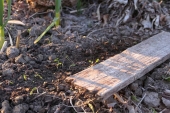Here's a few videos with more details on the method, you can find a lot more good info out there if you look:
Some things that have done really well for me sown in the cold months include: lettuce, spinach, half-long or short carrots, bachelor's buttons, anything that typically likes to be planted in fall, self-reseeds or needs cold stratification... those things that like some cold but not a hard freeze and don't have a long taproot.
Some things I like to start indoors and then put the sprouted seeds in cloches to grow in the spring (I call this half winter sowing): tomatoes, tomatillos, zinnias
Things that haven't worked for me using this method: peppers seem to just like more heat, cucurbits, radishes I don't see much point...
I've predominantly used this to start vegetables for spring and summer in the last couple of years but this year I'm going to be trying more flowers as well.








